Strategic Analysis and Implementation Challenges: A Business Report
VerifiedAdded on 2020/01/07
|9
|2431
|167
Report
AI Summary
This report delves into strategic management, offering a comprehensive analysis of a company's current operating activities. It begins with an introduction to strategic analysis and its role in achieving sustainable market competition. The core of the report comprises a detailed PESTAL analysis, examining the political, economic, social, technological, environmental, and legal factors influencing the company's strategic position. Furthermore, the report applies Porter's Five Forces model to assess the competitive landscape, evaluating the threat of new entrants, bargaining power of buyers and suppliers, threat of substitutes, and industry rivalry. It also explores strategic mapping as a tool for data analysis and communication of strategies. Finally, the report identifies and discusses key implementation challenges, such as stakeholder availability, changing requirements, development changes, change management, and challenges during user acceptance training, providing insights into the practical aspects of strategic execution.
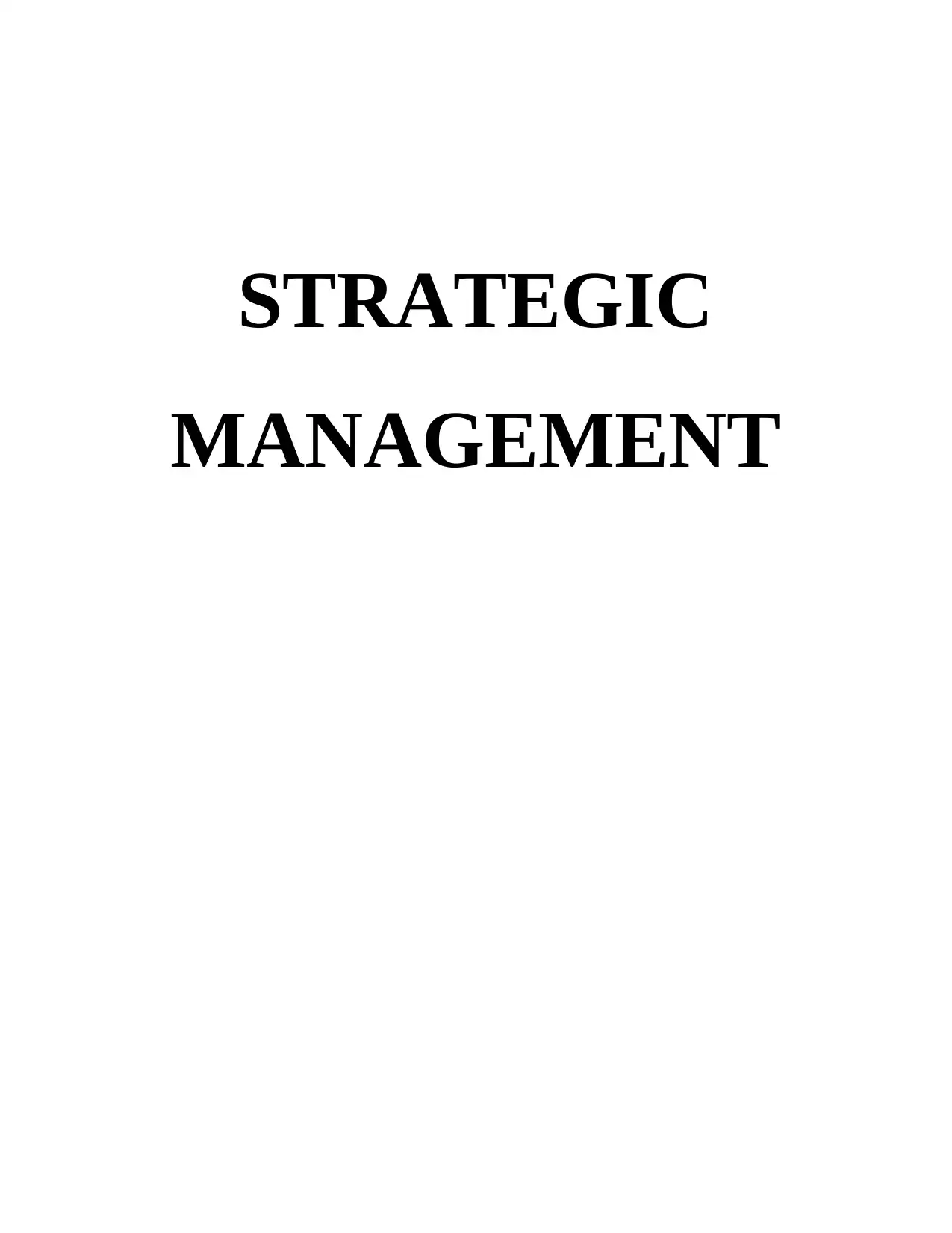
STRATEGIC
MANAGEMENT
MANAGEMENT
Paraphrase This Document
Need a fresh take? Get an instant paraphrase of this document with our AI Paraphraser
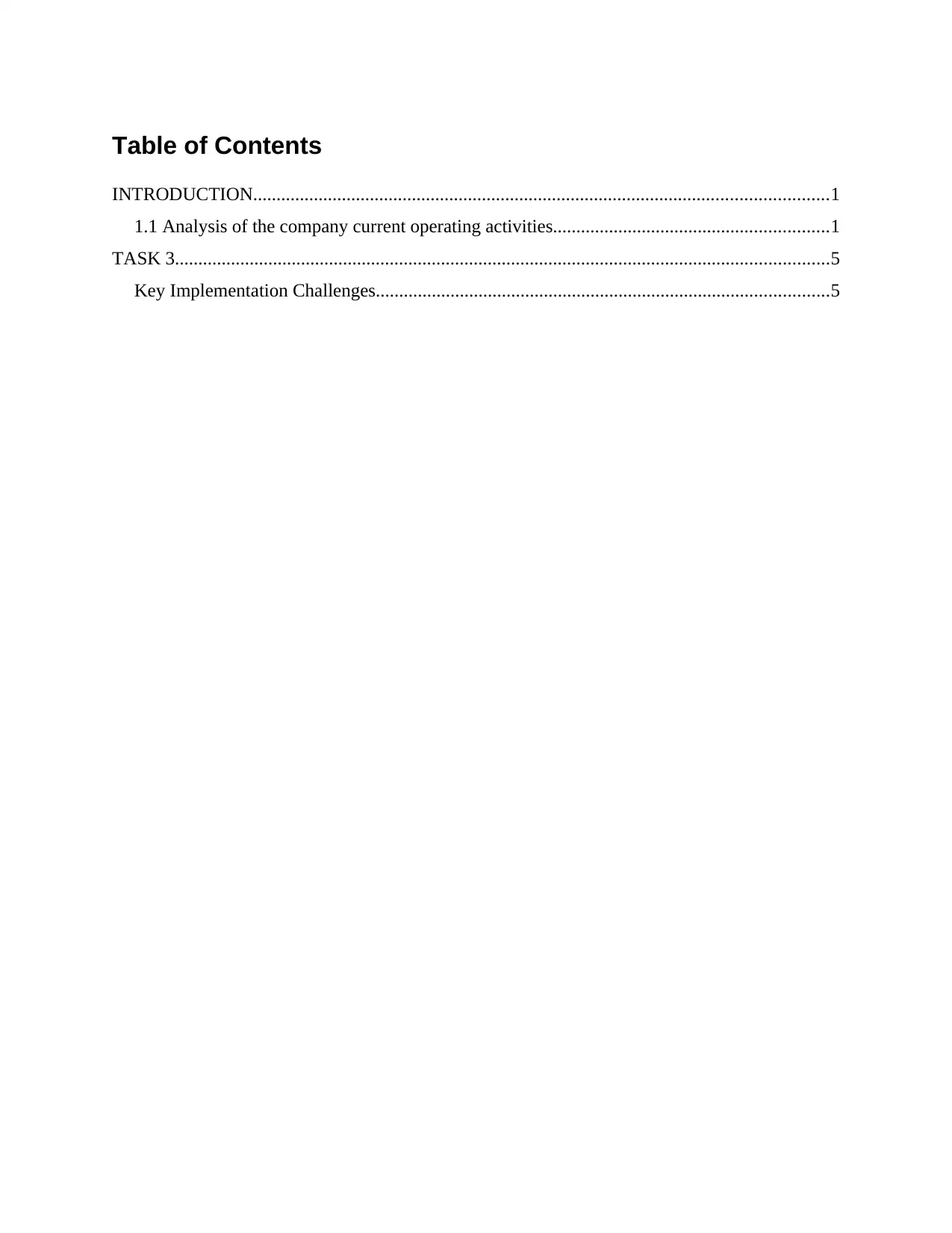
Table of Contents
INTRODUCTION...........................................................................................................................1
1.1 Analysis of the company current operating activities...........................................................1
TASK 3............................................................................................................................................5
Key Implementation Challenges.................................................................................................5
INTRODUCTION...........................................................................................................................1
1.1 Analysis of the company current operating activities...........................................................1
TASK 3............................................................................................................................................5
Key Implementation Challenges.................................................................................................5
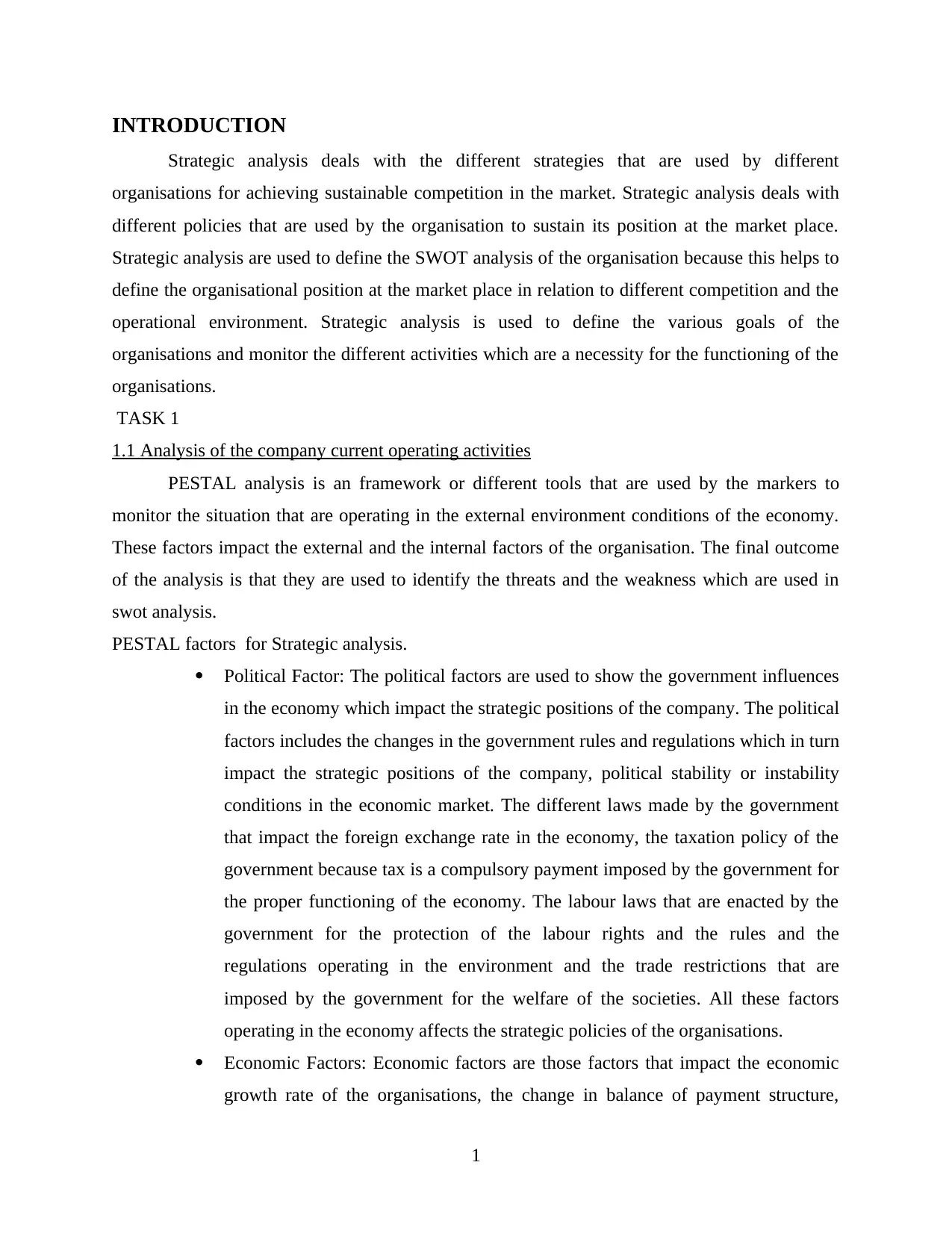
INTRODUCTION
Strategic analysis deals with the different strategies that are used by different
organisations for achieving sustainable competition in the market. Strategic analysis deals with
different policies that are used by the organisation to sustain its position at the market place.
Strategic analysis are used to define the SWOT analysis of the organisation because this helps to
define the organisational position at the market place in relation to different competition and the
operational environment. Strategic analysis is used to define the various goals of the
organisations and monitor the different activities which are a necessity for the functioning of the
organisations.
TASK 1
1.1 Analysis of the company current operating activities
PESTAL analysis is an framework or different tools that are used by the markers to
monitor the situation that are operating in the external environment conditions of the economy.
These factors impact the external and the internal factors of the organisation. The final outcome
of the analysis is that they are used to identify the threats and the weakness which are used in
swot analysis.
PESTAL factors for Strategic analysis.
Political Factor: The political factors are used to show the government influences
in the economy which impact the strategic positions of the company. The political
factors includes the changes in the government rules and regulations which in turn
impact the strategic positions of the company, political stability or instability
conditions in the economic market. The different laws made by the government
that impact the foreign exchange rate in the economy, the taxation policy of the
government because tax is a compulsory payment imposed by the government for
the proper functioning of the economy. The labour laws that are enacted by the
government for the protection of the labour rights and the rules and the
regulations operating in the environment and the trade restrictions that are
imposed by the government for the welfare of the societies. All these factors
operating in the economy affects the strategic policies of the organisations.
Economic Factors: Economic factors are those factors that impact the economic
growth rate of the organisations, the change in balance of payment structure,
1
Strategic analysis deals with the different strategies that are used by different
organisations for achieving sustainable competition in the market. Strategic analysis deals with
different policies that are used by the organisation to sustain its position at the market place.
Strategic analysis are used to define the SWOT analysis of the organisation because this helps to
define the organisational position at the market place in relation to different competition and the
operational environment. Strategic analysis is used to define the various goals of the
organisations and monitor the different activities which are a necessity for the functioning of the
organisations.
TASK 1
1.1 Analysis of the company current operating activities
PESTAL analysis is an framework or different tools that are used by the markers to
monitor the situation that are operating in the external environment conditions of the economy.
These factors impact the external and the internal factors of the organisation. The final outcome
of the analysis is that they are used to identify the threats and the weakness which are used in
swot analysis.
PESTAL factors for Strategic analysis.
Political Factor: The political factors are used to show the government influences
in the economy which impact the strategic positions of the company. The political
factors includes the changes in the government rules and regulations which in turn
impact the strategic positions of the company, political stability or instability
conditions in the economic market. The different laws made by the government
that impact the foreign exchange rate in the economy, the taxation policy of the
government because tax is a compulsory payment imposed by the government for
the proper functioning of the economy. The labour laws that are enacted by the
government for the protection of the labour rights and the rules and the
regulations operating in the environment and the trade restrictions that are
imposed by the government for the welfare of the societies. All these factors
operating in the economy affects the strategic policies of the organisations.
Economic Factors: Economic factors are those factors that impact the economic
growth rate of the organisations, the change in balance of payment structure,
1
⊘ This is a preview!⊘
Do you want full access?
Subscribe today to unlock all pages.

Trusted by 1+ million students worldwide
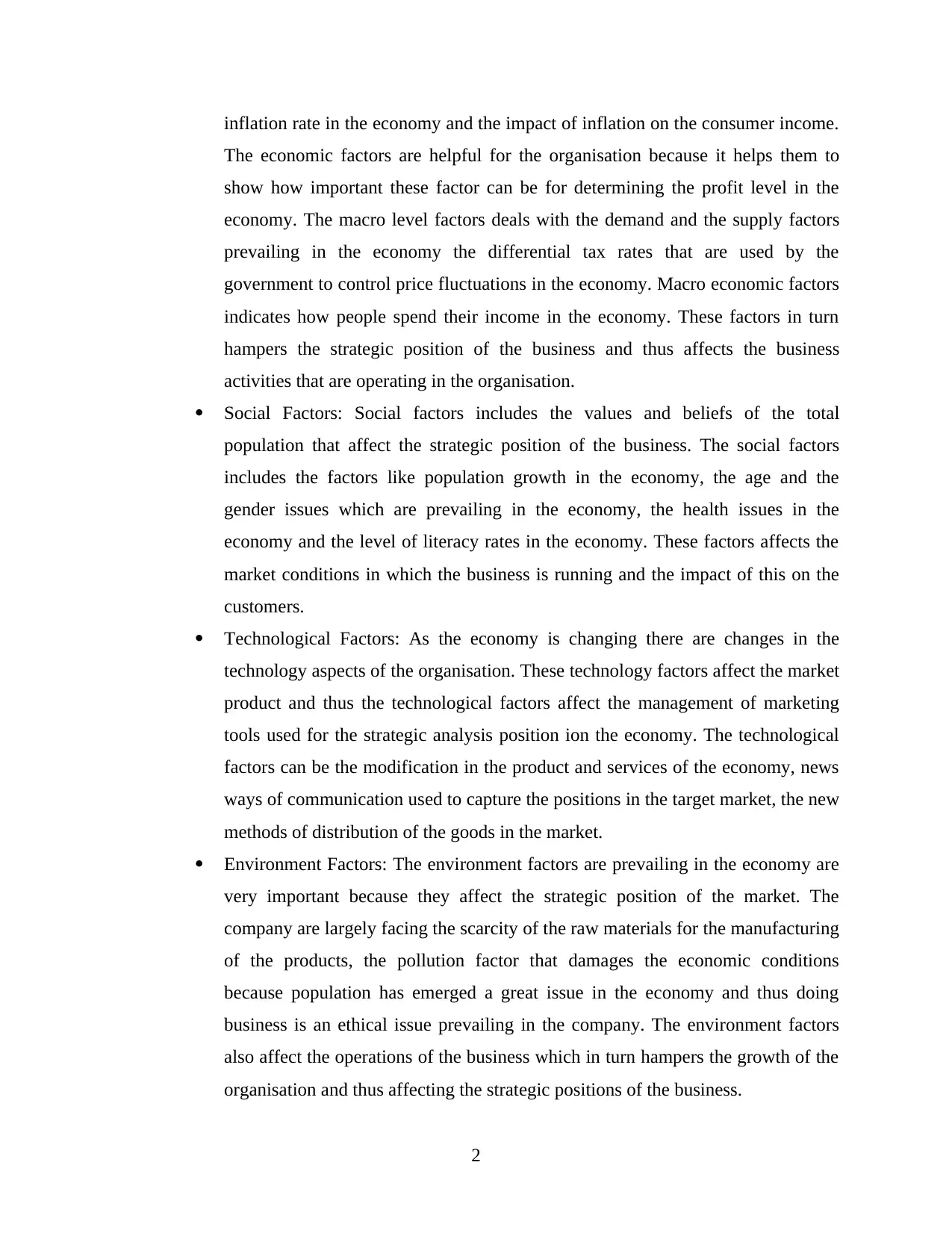
inflation rate in the economy and the impact of inflation on the consumer income.
The economic factors are helpful for the organisation because it helps them to
show how important these factor can be for determining the profit level in the
economy. The macro level factors deals with the demand and the supply factors
prevailing in the economy the differential tax rates that are used by the
government to control price fluctuations in the economy. Macro economic factors
indicates how people spend their income in the economy. These factors in turn
hampers the strategic position of the business and thus affects the business
activities that are operating in the organisation.
Social Factors: Social factors includes the values and beliefs of the total
population that affect the strategic position of the business. The social factors
includes the factors like population growth in the economy, the age and the
gender issues which are prevailing in the economy, the health issues in the
economy and the level of literacy rates in the economy. These factors affects the
market conditions in which the business is running and the impact of this on the
customers.
Technological Factors: As the economy is changing there are changes in the
technology aspects of the organisation. These technology factors affect the market
product and thus the technological factors affect the management of marketing
tools used for the strategic analysis position ion the economy. The technological
factors can be the modification in the product and services of the economy, news
ways of communication used to capture the positions in the target market, the new
methods of distribution of the goods in the market.
Environment Factors: The environment factors are prevailing in the economy are
very important because they affect the strategic position of the market. The
company are largely facing the scarcity of the raw materials for the manufacturing
of the products, the pollution factor that damages the economic conditions
because population has emerged a great issue in the economy and thus doing
business is an ethical issue prevailing in the company. The environment factors
also affect the operations of the business which in turn hampers the growth of the
organisation and thus affecting the strategic positions of the business.
2
The economic factors are helpful for the organisation because it helps them to
show how important these factor can be for determining the profit level in the
economy. The macro level factors deals with the demand and the supply factors
prevailing in the economy the differential tax rates that are used by the
government to control price fluctuations in the economy. Macro economic factors
indicates how people spend their income in the economy. These factors in turn
hampers the strategic position of the business and thus affects the business
activities that are operating in the organisation.
Social Factors: Social factors includes the values and beliefs of the total
population that affect the strategic position of the business. The social factors
includes the factors like population growth in the economy, the age and the
gender issues which are prevailing in the economy, the health issues in the
economy and the level of literacy rates in the economy. These factors affects the
market conditions in which the business is running and the impact of this on the
customers.
Technological Factors: As the economy is changing there are changes in the
technology aspects of the organisation. These technology factors affect the market
product and thus the technological factors affect the management of marketing
tools used for the strategic analysis position ion the economy. The technological
factors can be the modification in the product and services of the economy, news
ways of communication used to capture the positions in the target market, the new
methods of distribution of the goods in the market.
Environment Factors: The environment factors are prevailing in the economy are
very important because they affect the strategic position of the market. The
company are largely facing the scarcity of the raw materials for the manufacturing
of the products, the pollution factor that damages the economic conditions
because population has emerged a great issue in the economy and thus doing
business is an ethical issue prevailing in the company. The environment factors
also affect the operations of the business which in turn hampers the growth of the
organisation and thus affecting the strategic positions of the business.
2
Paraphrase This Document
Need a fresh take? Get an instant paraphrase of this document with our AI Paraphraser
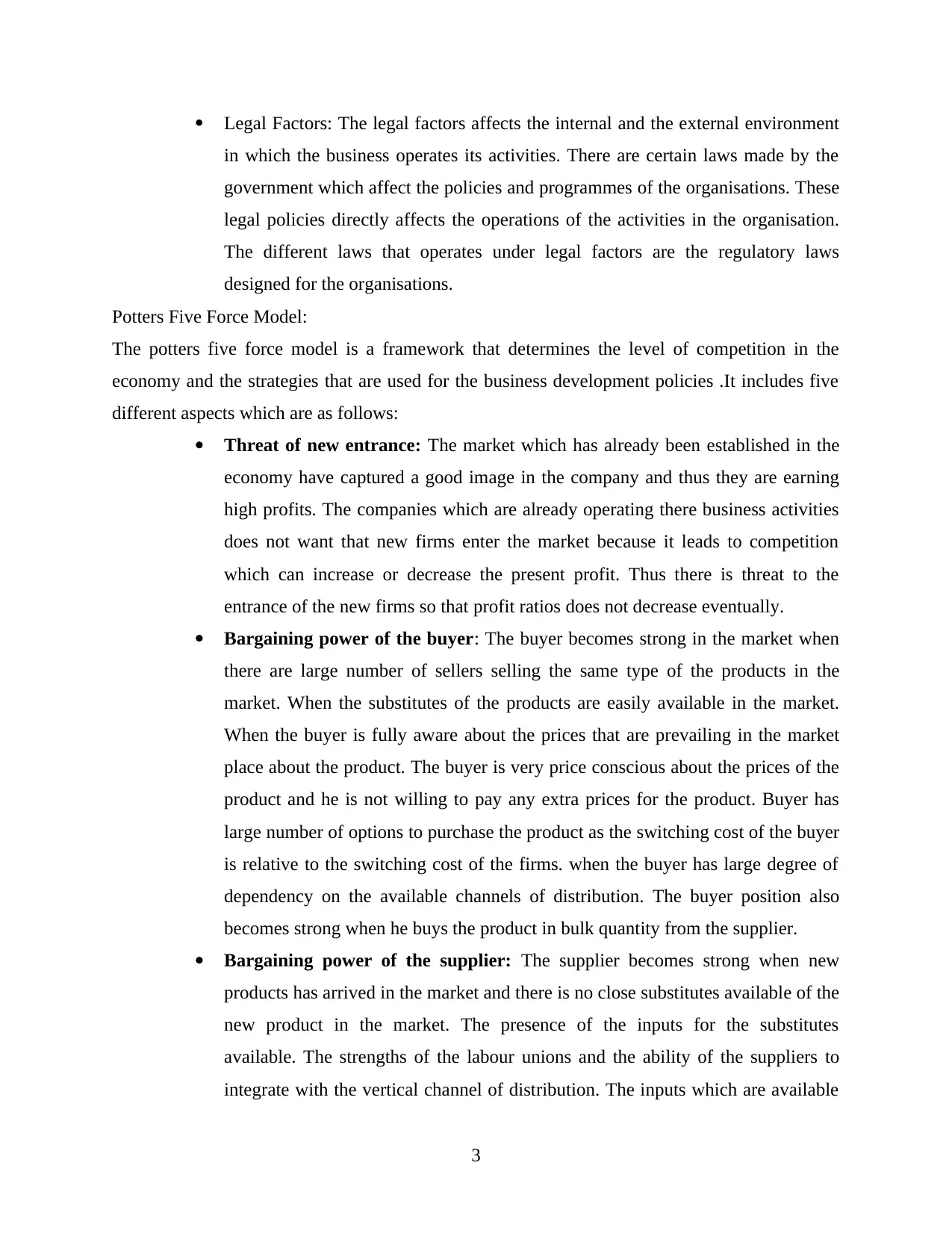
Legal Factors: The legal factors affects the internal and the external environment
in which the business operates its activities. There are certain laws made by the
government which affect the policies and programmes of the organisations. These
legal policies directly affects the operations of the activities in the organisation.
The different laws that operates under legal factors are the regulatory laws
designed for the organisations.
Potters Five Force Model:
The potters five force model is a framework that determines the level of competition in the
economy and the strategies that are used for the business development policies .It includes five
different aspects which are as follows:
Threat of new entrance: The market which has already been established in the
economy have captured a good image in the company and thus they are earning
high profits. The companies which are already operating there business activities
does not want that new firms enter the market because it leads to competition
which can increase or decrease the present profit. Thus there is threat to the
entrance of the new firms so that profit ratios does not decrease eventually.
Bargaining power of the buyer: The buyer becomes strong in the market when
there are large number of sellers selling the same type of the products in the
market. When the substitutes of the products are easily available in the market.
When the buyer is fully aware about the prices that are prevailing in the market
place about the product. The buyer is very price conscious about the prices of the
product and he is not willing to pay any extra prices for the product. Buyer has
large number of options to purchase the product as the switching cost of the buyer
is relative to the switching cost of the firms. when the buyer has large degree of
dependency on the available channels of distribution. The buyer position also
becomes strong when he buys the product in bulk quantity from the supplier.
Bargaining power of the supplier: The supplier becomes strong when new
products has arrived in the market and there is no close substitutes available of the
new product in the market. The presence of the inputs for the substitutes
available. The strengths of the labour unions and the ability of the suppliers to
integrate with the vertical channel of distribution. The inputs which are available
3
in which the business operates its activities. There are certain laws made by the
government which affect the policies and programmes of the organisations. These
legal policies directly affects the operations of the activities in the organisation.
The different laws that operates under legal factors are the regulatory laws
designed for the organisations.
Potters Five Force Model:
The potters five force model is a framework that determines the level of competition in the
economy and the strategies that are used for the business development policies .It includes five
different aspects which are as follows:
Threat of new entrance: The market which has already been established in the
economy have captured a good image in the company and thus they are earning
high profits. The companies which are already operating there business activities
does not want that new firms enter the market because it leads to competition
which can increase or decrease the present profit. Thus there is threat to the
entrance of the new firms so that profit ratios does not decrease eventually.
Bargaining power of the buyer: The buyer becomes strong in the market when
there are large number of sellers selling the same type of the products in the
market. When the substitutes of the products are easily available in the market.
When the buyer is fully aware about the prices that are prevailing in the market
place about the product. The buyer is very price conscious about the prices of the
product and he is not willing to pay any extra prices for the product. Buyer has
large number of options to purchase the product as the switching cost of the buyer
is relative to the switching cost of the firms. when the buyer has large degree of
dependency on the available channels of distribution. The buyer position also
becomes strong when he buys the product in bulk quantity from the supplier.
Bargaining power of the supplier: The supplier becomes strong when new
products has arrived in the market and there is no close substitutes available of the
new product in the market. The presence of the inputs for the substitutes
available. The strengths of the labour unions and the ability of the suppliers to
integrate with the vertical channel of distribution. The inputs which are available
3
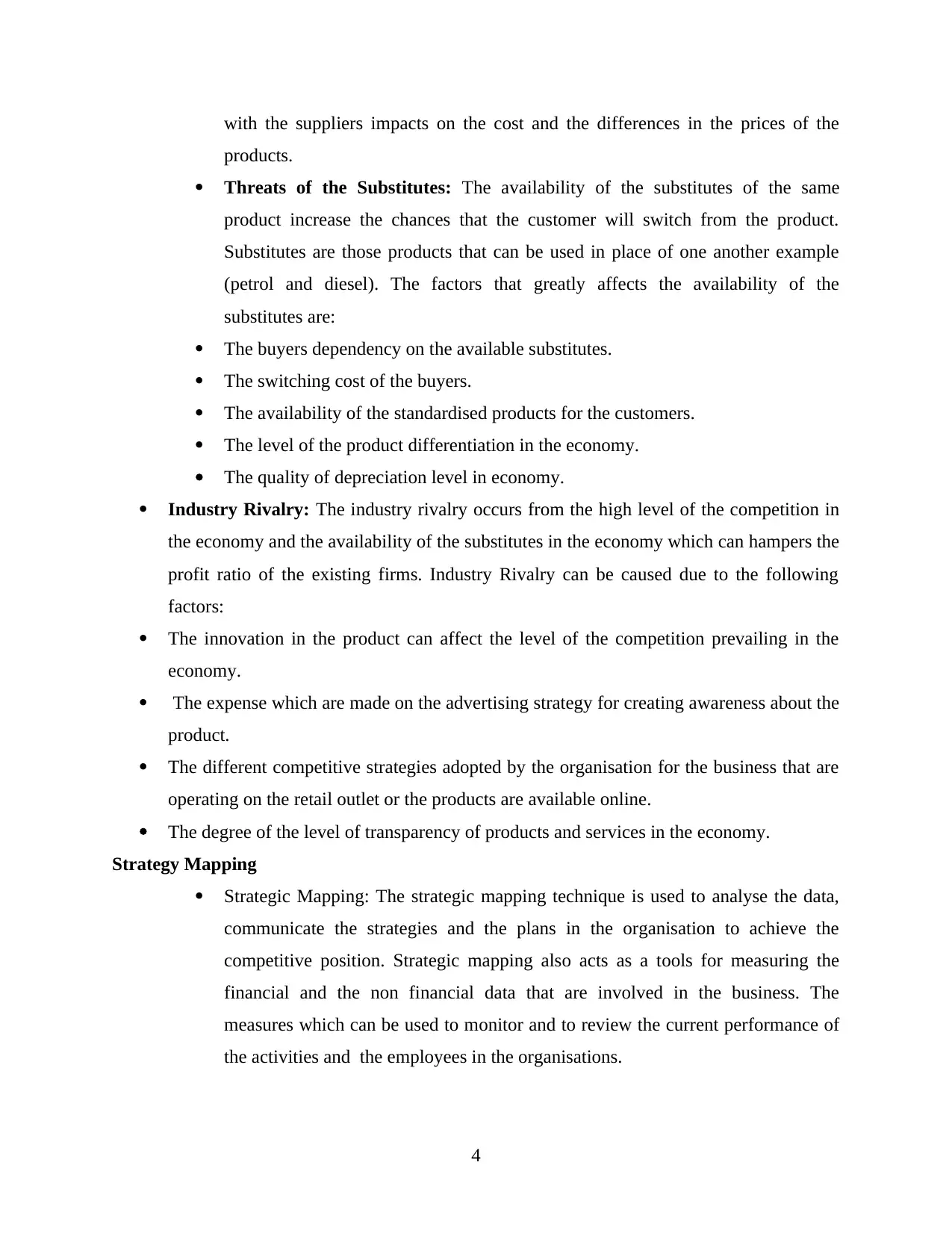
with the suppliers impacts on the cost and the differences in the prices of the
products.
Threats of the Substitutes: The availability of the substitutes of the same
product increase the chances that the customer will switch from the product.
Substitutes are those products that can be used in place of one another example
(petrol and diesel). The factors that greatly affects the availability of the
substitutes are:
The buyers dependency on the available substitutes.
The switching cost of the buyers.
The availability of the standardised products for the customers.
The level of the product differentiation in the economy.
The quality of depreciation level in economy.
Industry Rivalry: The industry rivalry occurs from the high level of the competition in
the economy and the availability of the substitutes in the economy which can hampers the
profit ratio of the existing firms. Industry Rivalry can be caused due to the following
factors:
The innovation in the product can affect the level of the competition prevailing in the
economy.
The expense which are made on the advertising strategy for creating awareness about the
product.
The different competitive strategies adopted by the organisation for the business that are
operating on the retail outlet or the products are available online.
The degree of the level of transparency of products and services in the economy.
Strategy Mapping
Strategic Mapping: The strategic mapping technique is used to analyse the data,
communicate the strategies and the plans in the organisation to achieve the
competitive position. Strategic mapping also acts as a tools for measuring the
financial and the non financial data that are involved in the business. The
measures which can be used to monitor and to review the current performance of
the activities and the employees in the organisations.
4
products.
Threats of the Substitutes: The availability of the substitutes of the same
product increase the chances that the customer will switch from the product.
Substitutes are those products that can be used in place of one another example
(petrol and diesel). The factors that greatly affects the availability of the
substitutes are:
The buyers dependency on the available substitutes.
The switching cost of the buyers.
The availability of the standardised products for the customers.
The level of the product differentiation in the economy.
The quality of depreciation level in economy.
Industry Rivalry: The industry rivalry occurs from the high level of the competition in
the economy and the availability of the substitutes in the economy which can hampers the
profit ratio of the existing firms. Industry Rivalry can be caused due to the following
factors:
The innovation in the product can affect the level of the competition prevailing in the
economy.
The expense which are made on the advertising strategy for creating awareness about the
product.
The different competitive strategies adopted by the organisation for the business that are
operating on the retail outlet or the products are available online.
The degree of the level of transparency of products and services in the economy.
Strategy Mapping
Strategic Mapping: The strategic mapping technique is used to analyse the data,
communicate the strategies and the plans in the organisation to achieve the
competitive position. Strategic mapping also acts as a tools for measuring the
financial and the non financial data that are involved in the business. The
measures which can be used to monitor and to review the current performance of
the activities and the employees in the organisations.
4
⊘ This is a preview!⊘
Do you want full access?
Subscribe today to unlock all pages.

Trusted by 1+ million students worldwide
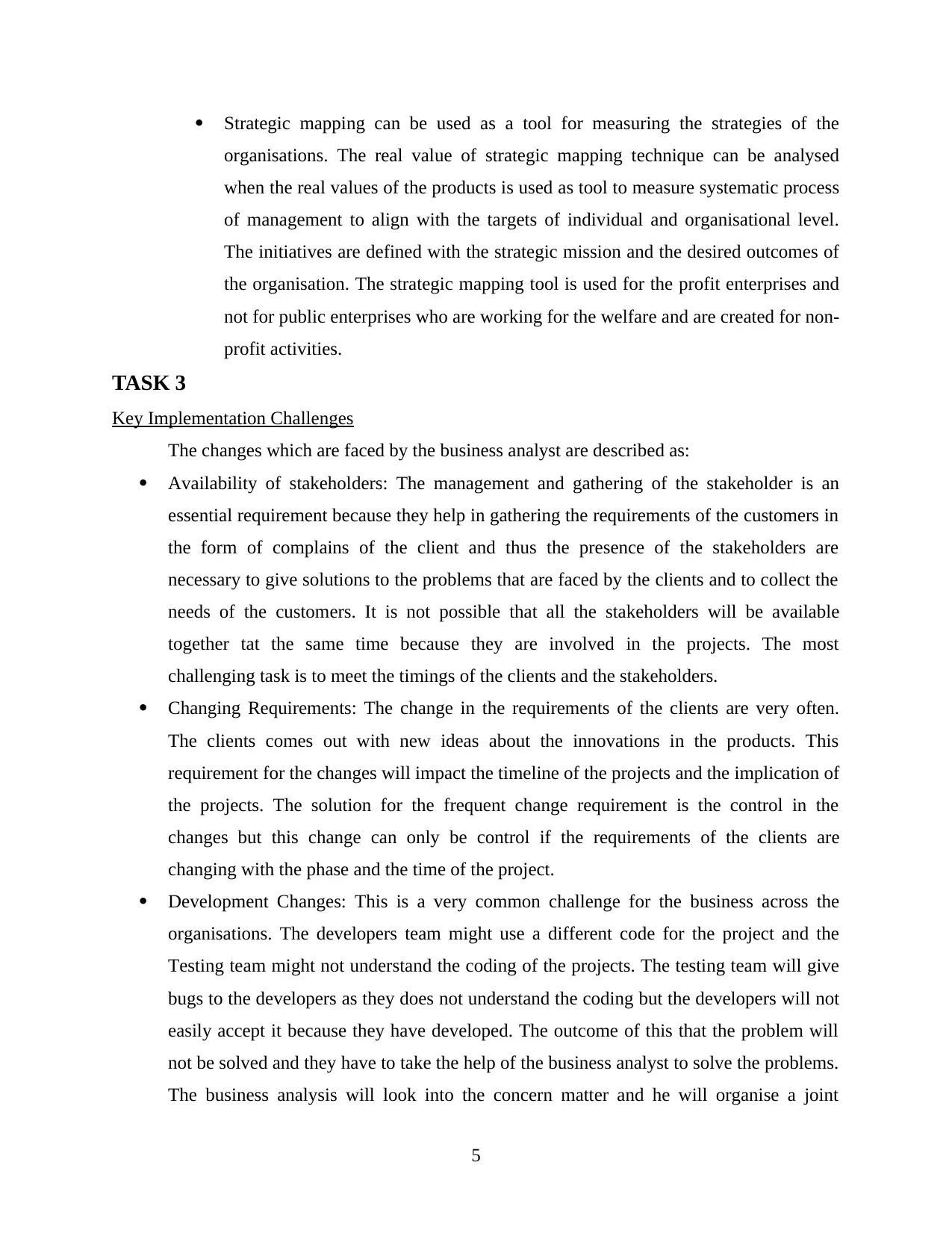
Strategic mapping can be used as a tool for measuring the strategies of the
organisations. The real value of strategic mapping technique can be analysed
when the real values of the products is used as tool to measure systematic process
of management to align with the targets of individual and organisational level.
The initiatives are defined with the strategic mission and the desired outcomes of
the organisation. The strategic mapping tool is used for the profit enterprises and
not for public enterprises who are working for the welfare and are created for non-
profit activities.
TASK 3
Key Implementation Challenges
The changes which are faced by the business analyst are described as:
Availability of stakeholders: The management and gathering of the stakeholder is an
essential requirement because they help in gathering the requirements of the customers in
the form of complains of the client and thus the presence of the stakeholders are
necessary to give solutions to the problems that are faced by the clients and to collect the
needs of the customers. It is not possible that all the stakeholders will be available
together tat the same time because they are involved in the projects. The most
challenging task is to meet the timings of the clients and the stakeholders.
Changing Requirements: The change in the requirements of the clients are very often.
The clients comes out with new ideas about the innovations in the products. This
requirement for the changes will impact the timeline of the projects and the implication of
the projects. The solution for the frequent change requirement is the control in the
changes but this change can only be control if the requirements of the clients are
changing with the phase and the time of the project.
Development Changes: This is a very common challenge for the business across the
organisations. The developers team might use a different code for the project and the
Testing team might not understand the coding of the projects. The testing team will give
bugs to the developers as they does not understand the coding but the developers will not
easily accept it because they have developed. The outcome of this that the problem will
not be solved and they have to take the help of the business analyst to solve the problems.
The business analysis will look into the concern matter and he will organise a joint
5
organisations. The real value of strategic mapping technique can be analysed
when the real values of the products is used as tool to measure systematic process
of management to align with the targets of individual and organisational level.
The initiatives are defined with the strategic mission and the desired outcomes of
the organisation. The strategic mapping tool is used for the profit enterprises and
not for public enterprises who are working for the welfare and are created for non-
profit activities.
TASK 3
Key Implementation Challenges
The changes which are faced by the business analyst are described as:
Availability of stakeholders: The management and gathering of the stakeholder is an
essential requirement because they help in gathering the requirements of the customers in
the form of complains of the client and thus the presence of the stakeholders are
necessary to give solutions to the problems that are faced by the clients and to collect the
needs of the customers. It is not possible that all the stakeholders will be available
together tat the same time because they are involved in the projects. The most
challenging task is to meet the timings of the clients and the stakeholders.
Changing Requirements: The change in the requirements of the clients are very often.
The clients comes out with new ideas about the innovations in the products. This
requirement for the changes will impact the timeline of the projects and the implication of
the projects. The solution for the frequent change requirement is the control in the
changes but this change can only be control if the requirements of the clients are
changing with the phase and the time of the project.
Development Changes: This is a very common challenge for the business across the
organisations. The developers team might use a different code for the project and the
Testing team might not understand the coding of the projects. The testing team will give
bugs to the developers as they does not understand the coding but the developers will not
easily accept it because they have developed. The outcome of this that the problem will
not be solved and they have to take the help of the business analyst to solve the problems.
The business analysis will look into the concern matter and he will organise a joint
5
Paraphrase This Document
Need a fresh take? Get an instant paraphrase of this document with our AI Paraphraser
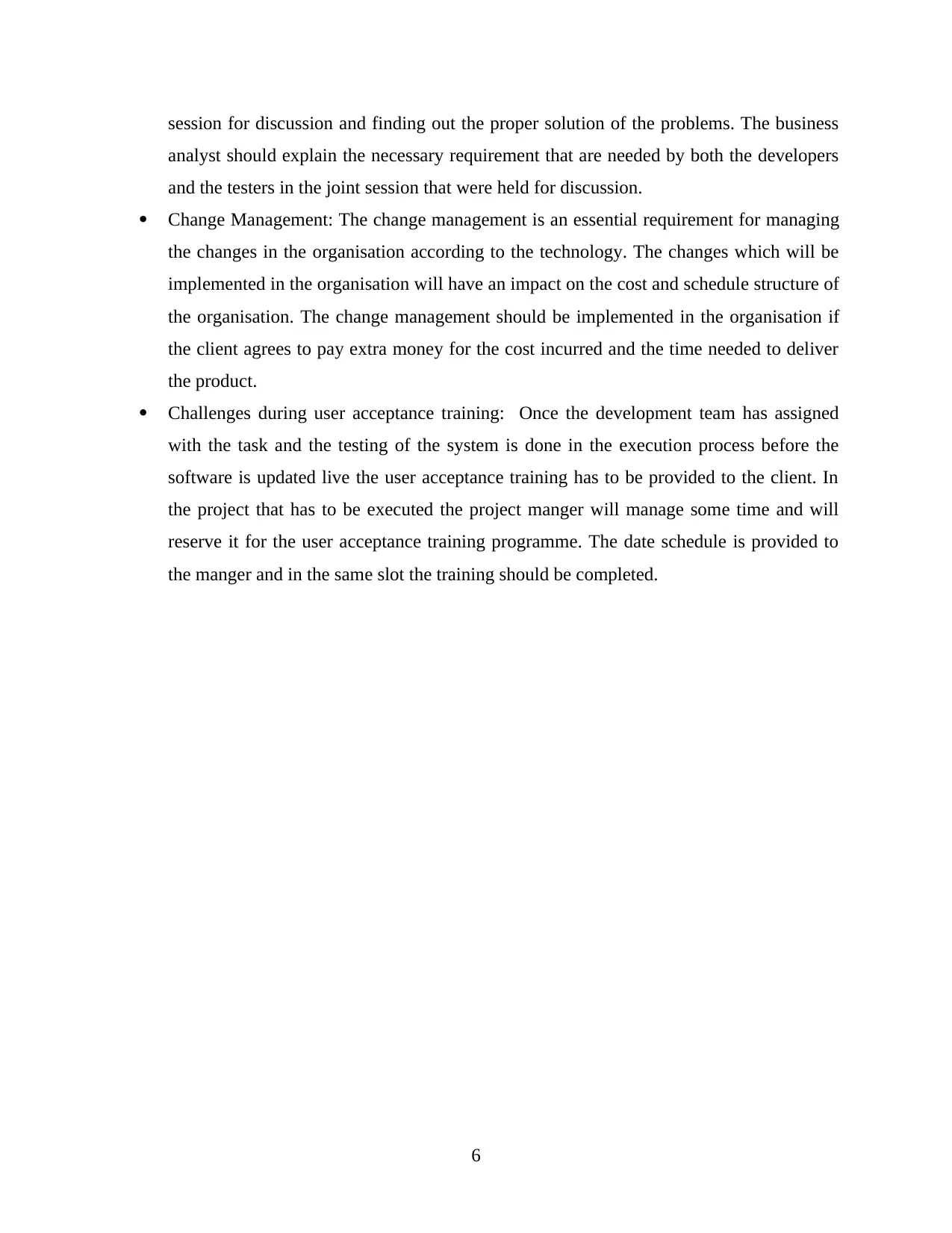
session for discussion and finding out the proper solution of the problems. The business
analyst should explain the necessary requirement that are needed by both the developers
and the testers in the joint session that were held for discussion.
Change Management: The change management is an essential requirement for managing
the changes in the organisation according to the technology. The changes which will be
implemented in the organisation will have an impact on the cost and schedule structure of
the organisation. The change management should be implemented in the organisation if
the client agrees to pay extra money for the cost incurred and the time needed to deliver
the product.
Challenges during user acceptance training: Once the development team has assigned
with the task and the testing of the system is done in the execution process before the
software is updated live the user acceptance training has to be provided to the client. In
the project that has to be executed the project manger will manage some time and will
reserve it for the user acceptance training programme. The date schedule is provided to
the manger and in the same slot the training should be completed.
6
analyst should explain the necessary requirement that are needed by both the developers
and the testers in the joint session that were held for discussion.
Change Management: The change management is an essential requirement for managing
the changes in the organisation according to the technology. The changes which will be
implemented in the organisation will have an impact on the cost and schedule structure of
the organisation. The change management should be implemented in the organisation if
the client agrees to pay extra money for the cost incurred and the time needed to deliver
the product.
Challenges during user acceptance training: Once the development team has assigned
with the task and the testing of the system is done in the execution process before the
software is updated live the user acceptance training has to be provided to the client. In
the project that has to be executed the project manger will manage some time and will
reserve it for the user acceptance training programme. The date schedule is provided to
the manger and in the same slot the training should be completed.
6
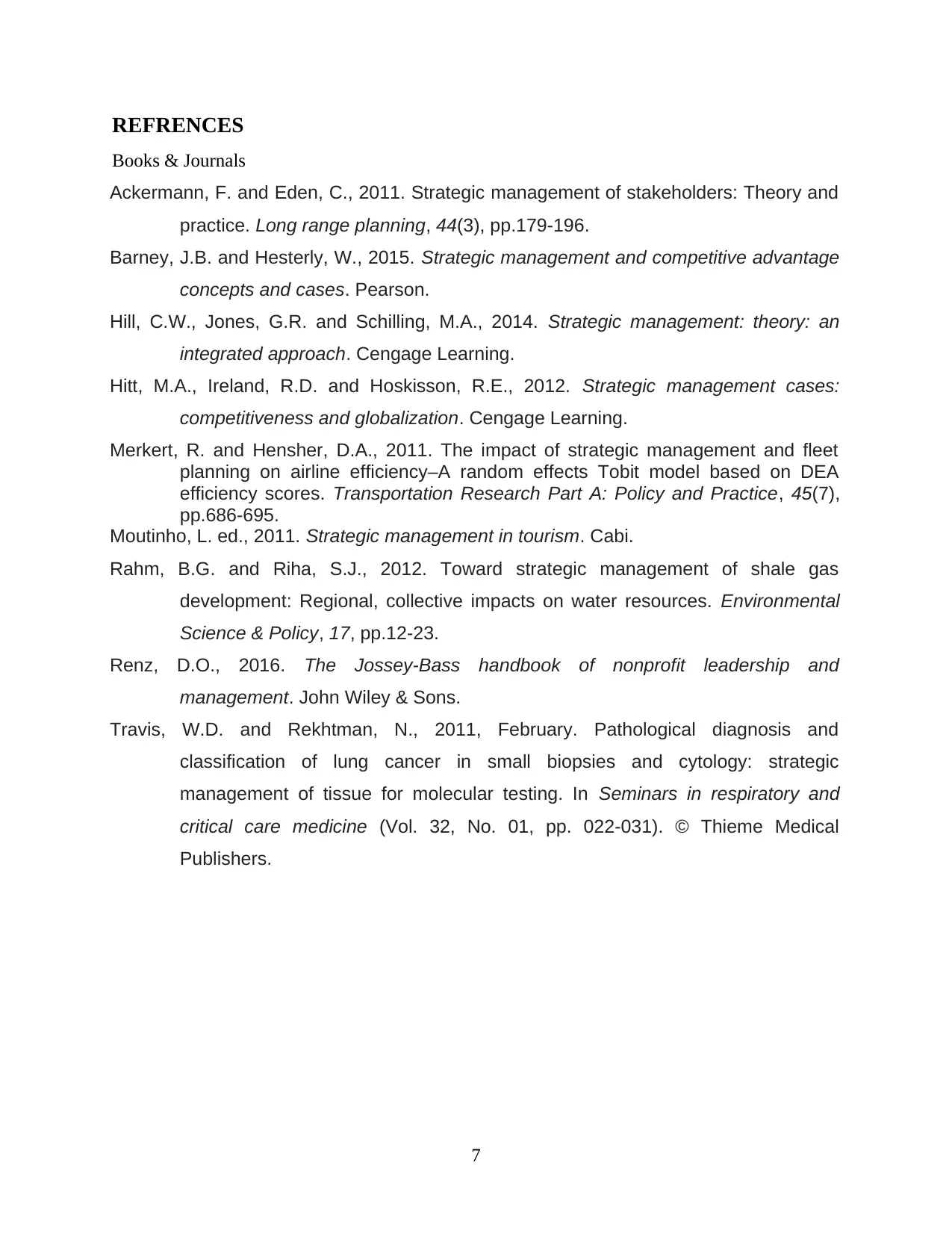
REFRENCES
Books & Journals
Ackermann, F. and Eden, C., 2011. Strategic management of stakeholders: Theory and
practice. Long range planning, 44(3), pp.179-196.
Barney, J.B. and Hesterly, W., 2015. Strategic management and competitive advantage
concepts and cases. Pearson.
Hill, C.W., Jones, G.R. and Schilling, M.A., 2014. Strategic management: theory: an
integrated approach. Cengage Learning.
Hitt, M.A., Ireland, R.D. and Hoskisson, R.E., 2012. Strategic management cases:
competitiveness and globalization. Cengage Learning.
Merkert, R. and Hensher, D.A., 2011. The impact of strategic management and fleet
planning on airline efficiency–A random effects Tobit model based on DEA
efficiency scores. Transportation Research Part A: Policy and Practice, 45(7),
pp.686-695.
Moutinho, L. ed., 2011. Strategic management in tourism. Cabi.
Rahm, B.G. and Riha, S.J., 2012. Toward strategic management of shale gas
development: Regional, collective impacts on water resources. Environmental
Science & Policy, 17, pp.12-23.
Renz, D.O., 2016. The Jossey-Bass handbook of nonprofit leadership and
management. John Wiley & Sons.
Travis, W.D. and Rekhtman, N., 2011, February. Pathological diagnosis and
classification of lung cancer in small biopsies and cytology: strategic
management of tissue for molecular testing. In Seminars in respiratory and
critical care medicine (Vol. 32, No. 01, pp. 022-031). © Thieme Medical
Publishers.
7
Books & Journals
Ackermann, F. and Eden, C., 2011. Strategic management of stakeholders: Theory and
practice. Long range planning, 44(3), pp.179-196.
Barney, J.B. and Hesterly, W., 2015. Strategic management and competitive advantage
concepts and cases. Pearson.
Hill, C.W., Jones, G.R. and Schilling, M.A., 2014. Strategic management: theory: an
integrated approach. Cengage Learning.
Hitt, M.A., Ireland, R.D. and Hoskisson, R.E., 2012. Strategic management cases:
competitiveness and globalization. Cengage Learning.
Merkert, R. and Hensher, D.A., 2011. The impact of strategic management and fleet
planning on airline efficiency–A random effects Tobit model based on DEA
efficiency scores. Transportation Research Part A: Policy and Practice, 45(7),
pp.686-695.
Moutinho, L. ed., 2011. Strategic management in tourism. Cabi.
Rahm, B.G. and Riha, S.J., 2012. Toward strategic management of shale gas
development: Regional, collective impacts on water resources. Environmental
Science & Policy, 17, pp.12-23.
Renz, D.O., 2016. The Jossey-Bass handbook of nonprofit leadership and
management. John Wiley & Sons.
Travis, W.D. and Rekhtman, N., 2011, February. Pathological diagnosis and
classification of lung cancer in small biopsies and cytology: strategic
management of tissue for molecular testing. In Seminars in respiratory and
critical care medicine (Vol. 32, No. 01, pp. 022-031). © Thieme Medical
Publishers.
7
⊘ This is a preview!⊘
Do you want full access?
Subscribe today to unlock all pages.

Trusted by 1+ million students worldwide
1 out of 9
Related Documents
Your All-in-One AI-Powered Toolkit for Academic Success.
+13062052269
info@desklib.com
Available 24*7 on WhatsApp / Email
![[object Object]](/_next/static/media/star-bottom.7253800d.svg)
Unlock your academic potential
Copyright © 2020–2025 A2Z Services. All Rights Reserved. Developed and managed by ZUCOL.




